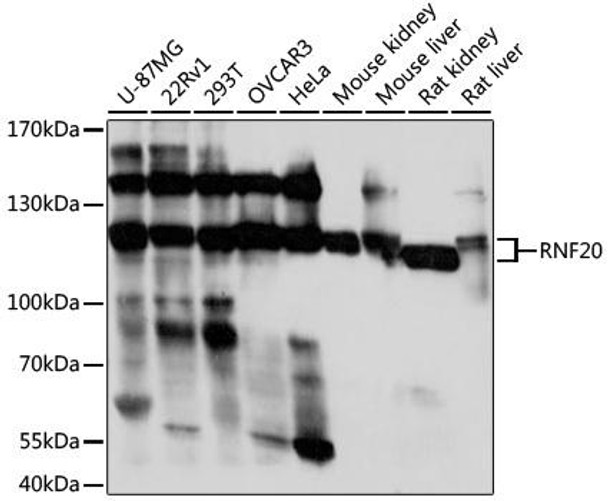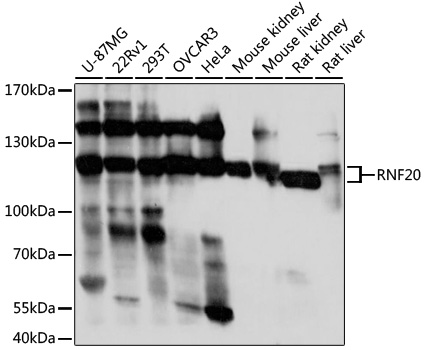Anti-RNF20 Antibody (CAB17309)
- SKU:
- CAB17309
- Product type:
- Antibody
- Reactivity:
- Human
- Mouse
- Rat
- Host Species:
- Rabbit
- Isotype:
- IgG
- Antibody Type:
- Polyclonal Antibody
- Research Area:
- Signal Transduction
Description
| Antibody Name: | Anti-RNF20 Antibody |
| Antibody SKU: | CAB17309 |
| Antibody Size: | 20uL, 50uL, 100uL |
| Application: | WB |
| Reactivity: | Human, Mouse, Rat |
| Host Species: | Rabbit |
| Immunogen: | Recombinant fusion protein containing a sequence corresponding to amino acids 1-260 of human RNF20 (NP_062538.5). |
| Application: | WB |
| Recommended Dilution: | WB 1:500 - 1:2000 |
| Reactivity: | Human, Mouse, Rat |
| Positive Samples: | U-87MG, 22Rv1, 293T, OVCAR3, HeLa, mouse kidney, mouse liver, rat kidney, rat liver |
| Immunogen: | Recombinant fusion protein containing a sequence corresponding to amino acids 1-260 of human RNF20 (NP_062538.5). |
| Purification Method: | Affinity purification |
| Storage Buffer: | Store at -20°C. Avoid freeze / thaw cycles. Buffer: PBS with 0.02% sodium azide, 50% glycerol, pH7.3. |
| Isotype: | IgG |
| Sequence: | MSGI GNKR AAGE PGTS MPPE KKAA VEDS GTTV ETIK LGGV SSTE ELDI RTLQ TKNR KLAE MLDQ RQAI EDEL REHI EKLE RRQA TDDA SLLI VNRY WSQF DENI RIIL KRYD LEQG LGDL LTER KALV VPEP EPDS DSNQ ERKD DRER GEGQ EPAF SFLA TLAS SSSE EMES QLQE RVES SRRA VSQI VTVY DKLQ EKVE LLSR KLNS GDNL IVEE AVQE LNSF LAQE NMRL QELT DLLQ EKHR TMSQ EFSK LQSK VETA |
| Gene ID: | 56254 |
| Uniprot: | Q5VTR2 |
| Cellular Location: | Nucleus |
| Calculated MW: | 113kDa |
| Observed MW: | 114kDa |
| Synonyms: | RNF20, BRE1, BRE1A, hBRE1 |
| Background: | The protein encoded by this gene shares similarity with BRE1 of S. cerevisiae. The protein encoded by this human gene is an E3 ubiquitin ligase that regulates chromosome structure by monoubiquitinating histone H2B. This protein acts as a putative tumor suppressor and positively regulates the p53 tumor suppressor as well as numerous histone H2A and H2B genes. In contrast, this protein also suppresses the expression of several protooncogenes and growth-related genes, including many genes that are induced by epidermal growth factor. This gene selectively suppresses the expression of some genes by interfering with chromatin recruitment of transcription elongation factor SII (TFIIS). |
| UniProt Protein Function: | RNF20: Component of the RNF20/40 E3 ubiquitin-protein ligase complex that mediates monoubiquitination of 'Lys-120' of histone H2B (H2BK120ub1). H2BK120ub1 gives a specific tag for epigenetic transcriptional activation and is also prerequisite for histone H3 'Lys-4' and 'Lys-79' methylation (H3K4me and H3K79me, respectively). It thereby plays a central role in histone code and gene regulation. The RNF20/40 complex forms a H2B ubiquitin ligase complex in cooperation with the E2 enzyme UBE2A or UBE2B; reports about the cooperation with UBE2E1/UBCH are contradictory. Required for transcriptional activation of Hox genes. Recruited to the MDM2 promoter, probably by being recruited by p53/TP53, and thereby acts as a transcriptional coactivator. Component of the RNF20/40 complex (also known as BRE1 complex) probably composed of 2 copies of RNF20/BRE1A and 2 copies of RNF40/BRE1B. Interacts with UBE2E1/UBCH6. Interacts with p53/TP53 and WAC. Interacts with PAF1; the interaction mediates the association of the PAF1 and RNF20/40 complexes which is a prerequsite for recruitment of UBE2A/B. Belongs to the BRE1 family. |
| UniProt Protein Details: | Protein type:EC 6.3.2.-; Ubiquitin conjugating system; Ubiquitin ligase; Ligase; EC 6.3.2.19 Chromosomal Location of Human Ortholog: 9q22 Cellular Component: nucleoplasm; nucleolus; nucleus; ubiquitin ligase complex Molecular Function:protein binding; mRNA 3'-UTR binding; histone binding; zinc ion binding; p53 binding; ubiquitin protein ligase binding; transcription coactivator activity; ubiquitin-protein ligase activity; chromatin binding; ligase activity Biological Process: ubiquitin-dependent protein catabolic process; histone monoubiquitination; protein polyubiquitination; positive regulation of histone methylation; regulation of transcription, DNA-dependent; positive regulation of transcription, DNA-dependent; regulation of mitotic cell cycle; histone H2B ubiquitination; negative regulation of cell migration |
| NCBI Summary: | The protein encoded by this gene shares similarity with BRE1 of S. cerevisiae. The protein encoded by this human gene is an E3 ubiquitin ligase that regulates chromosome structure by monoubiquitinating histone H2B. This protein acts as a putative tumor suppressor and positively regulates the p53 tumor suppressor as well as numerous histone H2A and H2B genes. In contrast, this protein also suppresses the expression of several protooncogenes and growth-related genes, including many genes that are induced by epidermal growth factor. This gene selectively suppresses the expression of some genes by interfering with chromatin recruitment of transcription elongation factor SII (TFIIS). [provided by RefSeq, Feb 2012] |
| UniProt Code: | Q5VTR2 |
| NCBI GenInfo Identifier: | 84027766 |
| NCBI Gene ID: | 56254 |
| NCBI Accession: | Q5VTR2.2 |
| UniProt Secondary Accession: | Q5VTR2,Q2TB34, Q69YL5, Q6P527, Q8N3J4, Q96JD3, Q9H9Y7 Q9HA51, Q9NUR4, Q9NWQ3, Q9NX83, A7MCT5, |
| UniProt Related Accession: | Q5VTR2 |
| Molecular Weight: | 975 |
| NCBI Full Name: | E3 ubiquitin-protein ligase BRE1A |
| NCBI Synonym Full Names: | ring finger protein 20, E3 ubiquitin protein ligase |
| NCBI Official Symbol: | RNF20 |
| NCBI Official Synonym Symbols: | BRE1; BRE1A; hBRE1 |
| NCBI Protein Information: | E3 ubiquitin-protein ligase BRE1A; BRE1-A; homolog of S. cerevisiae BRE1; BRE1 E3 ubiquitin ligase homolog |
| UniProt Protein Name: | E3 ubiquitin-protein ligase BRE1A |
| UniProt Synonym Protein Names: | RING finger protein 20 |
| Protein Family: | E3 ubiquitin-protein ligase |
| UniProt Gene Name: | RNF20 |
| UniProt Entry Name: | BRE1A_HUMAN |


